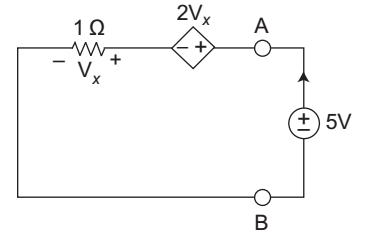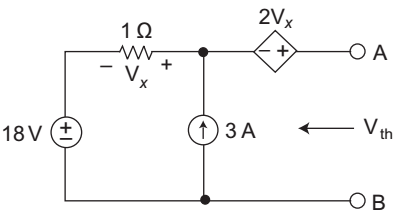Network Elements and the Concept of Circuit
- The complex power in the circuit shown below will be—

-
View Hint View Answer Discuss in Forum
Complex power is given by the relation
P = I V
given V = 10 sin (2t – 40°)V
for the given circuit
10 sin (2t – 40°) voltZ eq = 2 + 
2 + 1 
|| (1 + 5s) 5s
= 3.02 ∠ 6.3° at ω = 2I = V = 10 sin (2t – 40°) Zeq 3.02 – 6.3°
I = 3.3 sin (2t – 46.3°)
so, complex powerP = VI = Vm Im cos φ 2 P = 10 × 3.3 ∠ – 6.3° 2
or P = 16.5 ∠ – 6.3° wattsCorrect Option: A
Complex power is given by the relation
P = I V
given V = 10 sin (2t – 40°)V
for the given circuit
10 sin (2t – 40°) voltZ eq = 2 + 
2 + 1 
|| (1 + 5s) 5s
= 3.02 ∠ 6.3° at ω = 2I = V = 10 sin (2t – 40°) Zeq 3.02 – 6.3°
I = 3.3 sin (2t – 46.3°)
so, complex powerP = VI = Vm Im cos φ 2 P = 10 × 3.3 ∠ – 6.3° 2
or P = 16.5 ∠ – 6.3° watts
- The current I in the circuit will given by—

-
View Hint View Answer Discuss in Forum
Applying the KVL
10 = 1 I + 2 (I + 2) + 2 I
10 = I + 2 I + 4 + 2 I
10 – 4 = 5II = 6 = 1.2 amp. 5
Correct Option: B
Applying the KVL
10 = 1 I + 2 (I + 2) + 2 I
10 = I + 2 I + 4 + 2 I
10 – 4 = 5II = 6 = 1.2 amp. 5
- The Thevenin equivalent of the given at terminal a – b will be—

-
View Hint View Answer Discuss in Forum
Because we cannot connect a resistance in series with the current source.
Correct Option: D
Because we cannot connect a resistance in series with the current source.
- Find the Thevenin voltage and resistance for the network shown below across the terminal A.B—
-
View Hint View Answer Discuss in Forum
Calculation for Rth
To calculate Rth when dependent source are taking into account for this, assume a imaginary source say 5 V is connected across terminal A and B and current produced by that current source is I then Rth is given by the relation.
Rth = 5/1
the equivalent circuit for calculating Rth is shown below:
5 = 2 Vx + I. 1 ....(i)
Vx = 1. I
5 = 2 I + II = 5 Ω 3 
so, Rth = 5 = 3 Ω 5 / 3
Calculation for Vth:
Here the 3 A current source will drop across 1 Ω resistance
Vx = 3 × 1 = 3 V
or Vth = 2 Vx + Vx + 18
or Vth =3 Vx + 18 = 3 × 3 + 18 = 27 VCorrect Option: A
Calculation for Rth
To calculate Rth when dependent source are taking into account for this, assume a imaginary source say 5 V is connected across terminal A and B and current produced by that current source is I then Rth is given by the relation.
Rth = 5/1
the equivalent circuit for calculating Rth is shown below:
5 = 2 Vx + I. 1 ....(i)
Vx = 1. I
5 = 2 I + II = 5 Ω 3 
so, Rth = 5 = 3 Ω 5 / 3
Calculation for Vth:
Here the 3 A current source will drop across 1 Ω resistance
Vx = 3 × 1 = 3 V
or Vth = 2 Vx + Vx + 18
or Vth =3 Vx + 18 = 3 × 3 + 18 = 27 V
- The voltage of the source i.e. Vs, if i (t) = – 20 e– 2t
-
View Hint View Answer Discuss in Forum
Given i (t) = – 20 e– 2t
V (t) = – 20 e– 2t × 1 = – 20 e– 2t
iC = C dV (t) dt = 2. d (– 20 e– 2t) dt
or iC = 80 e– 2t
I = i (t) + i C = – 20 e– 2t + 80 e– 2t
= 60 e– 2t
Vs = VR + VL + V (t)= 1 × 60 e– 2t + L d i + V (t) dt = 1 × 60 e– 2t + 1 d 60 e– 2t – 20 e– t 4 dt
= 60 e– 2t – 15 × 2 e– 2t – 20 e– 2t
= 60 e– 2t – 30e– 2t – 20 e– 2t
= 10e– 2tCorrect Option: A
Given i (t) = – 20 e– 2t
V (t) = – 20 e– 2t × 1 = – 20 e– 2t
iC = C dV (t) dt = 2. d (– 20 e– 2t) dt
or iC = 80 e– 2t
I = i (t) + i C = – 20 e– 2t + 80 e– 2t
= 60 e– 2t
Vs = VR + VL + V (t)= 1 × 60 e– 2t + L d i + V (t) dt = 1 × 60 e– 2t + 1 d 60 e– 2t – 20 e– t 4 dt
= 60 e– 2t – 15 × 2 e– 2t – 20 e– 2t
= 60 e– 2t – 30e– 2t – 20 e– 2t
= 10e– 2t

